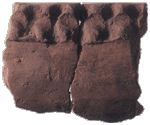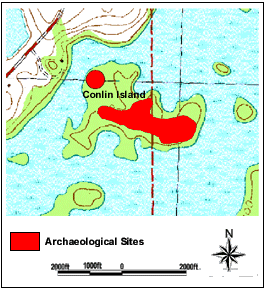Case Study
Because conservation easements under the IRS code do not specifically protect archaeological sites, we have provided an example to demonstrate how archaeological sites have been protected under a conservation easement.
Conlin Island
 The conservation easement for Conlin Island, located in Lake Iamonia near Tallahassee, Florida, includes the protection of cultural resources. State of Florida archaeologists found this artifact (left) at Conlin Island during an archaeological survey conducted in partnership with Red Hills Conservation Program of Tall Timbers Research Station, who holds the easement on the property. The artifact is a pinched-rim sherd of Lake Jackson Plain style, placing it in the Ft. Walton Period, ca. 1250-1450 AD. Norwood Plain and Deptford Plain sherds, along with lithic artifacts recovered suggest that Conlin Island may have been inhabited as early as 2500 years ago.
The conservation easement for Conlin Island, located in Lake Iamonia near Tallahassee, Florida, includes the protection of cultural resources. State of Florida archaeologists found this artifact (left) at Conlin Island during an archaeological survey conducted in partnership with Red Hills Conservation Program of Tall Timbers Research Station, who holds the easement on the property. The artifact is a pinched-rim sherd of Lake Jackson Plain style, placing it in the Ft. Walton Period, ca. 1250-1450 AD. Norwood Plain and Deptford Plain sherds, along with lithic artifacts recovered suggest that Conlin Island may have been inhabited as early as 2500 years ago.  The Conlin Island Conservation Easement map (right) shows the location of archaeologically sensitive areas found during the archaeological survey of the island. Often surveys are conducted on conservation easements to determine what resources exist on the property and where they are located. Each property being placed under conservation easement will be assessed based on the needs of the owner. Sometimes extensive surveys will be conducted and, other times, surface surveys of the property are all that is required.
The Conlin Island Conservation Easement map (right) shows the location of archaeologically sensitive areas found during the archaeological survey of the island. Often surveys are conducted on conservation easements to determine what resources exist on the property and where they are located. Each property being placed under conservation easement will be assessed based on the needs of the owner. Sometimes extensive surveys will be conducted and, other times, surface surveys of the property are all that is required.

